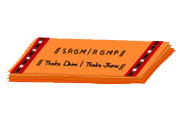Lyrics and Meanings (Sloka)
Śhloka is a term derived from Sanskrit. Śhloka is a verse, phrase, proverb or hymn of praise dedicated to the God.view more
Lyrics and Meanings (Sloka)
Śhloka is a term derived from Sanskrit. Śhloka is a verse, phrase, proverb or hymn of praise dedicated to the God. Śhlokas are usually composed in a specific meter. Śhloka is a verse of two lines, each of sixteen syllables. Usually the Śhloka selected is from our ancient Purāṇas or epics - Ithihāsa - and is set to a particular rāga and thāḷa.
The dancer would give expression to the bhāva that is underlying in the Śhloka, bringing out the deeper meaning laden in it. They may even construct swaras for the Śhloka and dance to them or they would perform a Thīrmānam for them. If there is no scope for Sanchāri Bhāva in the Śhloka, then the artiste would perform to the swaras in the rāga and execute thīrmānas or nruttha, accordingly, bringing out the qualities of the manifestation of God in whose praise the Śhloka is set.
The Śhloka is always centered on this mood of serenity, and is associated with devotion. It is the state in which a man transcends from his state of mind and is transported closest to the Divine, to the Supreme and the Ultimate. Though the Śhloka selected is mostly written in Sanskrit, the artistes usually select verses from the language of the particular region, or of their choice.
| 1 | Karāravindhena | click here |
| 2 | Kasthūri Thilakam | click here |












